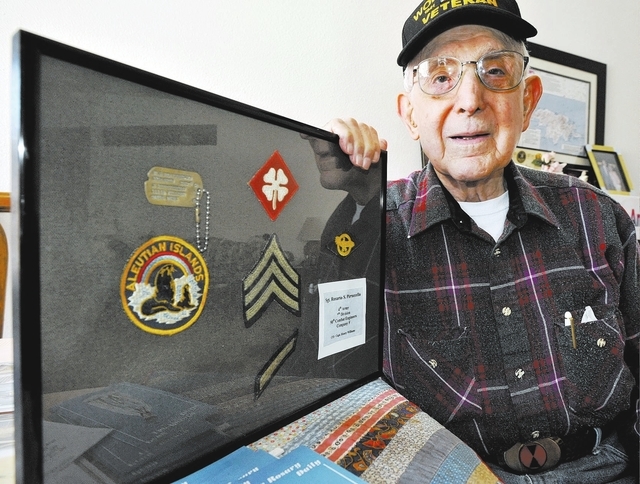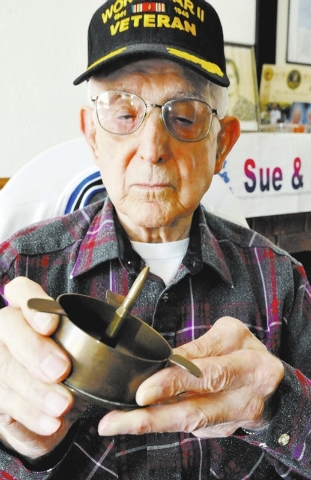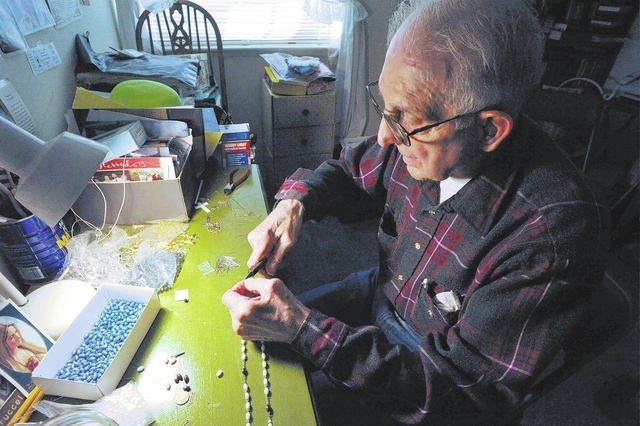Boulder City resident ready to tell his story





In the Boulder City home of World War II veteran Ross Pirruccello, there is a map in a wide black frame hanging on his living room wall above a mantelpiece laden with family photos and a small, white angel statue with one missing wing.
If a visitor comes, he walks them up to the map and tells what he remembers, as if the story is still fresh, as if he still cannot believe it is his story to tell.
The framed reminder is a map of the island of Attu in the North Pacific chain of islands known as the Aleutians, a crescent-shaped archipelago that dips from the southern tip of Alaska toward the Bering Sea. Seventy years ago, it was the site of the only World War II battle on U.S. territory and second only to Iwo Jima as, proportionately, the deadliest battle in the Pacific Theater.
Few have heard of it, however. What is often referred to as “the forgotten battle,” the Aleutians campaign was overshadowed by larger conflicts in the Pacific and, according to Pirruccello, kept quiet afterward by a U.S. military embarrassed by disastrous planning that severely underestimated both the enemy and the horrendous battle conditions.
The fight to take Attu was supposed to last three days but it took approximately 19, and U.S. soldiers were so under- equipped for the weather and terrain on the desolate island that about 2,100 were taken out of the action because of disease and nonbattle injuries alone, according to information gathered by the National Park Service about the battle area of Attu, which is now a National Historic Landmark.
“My daughter-in-law was here the other day. She said, ‘Ross, you never said anything.’ I said, ‘Most of us didn’t because they made us feel like we didn’t do our job. They made us feel like we had a guilty conscience because we were supposed to take the island in three days and we didn’t,’ ” he said.
A few years ago, Pirruccello, who is 92, decided it was finally time to give the details as he remembers them so he can help vindicate the men who suffered and died on Attu. He began talking to family and friends about it and hung that map on his wall.
His story begins like many World War II soldiers. He was living in his hometown of Omaha, Neb., when he joined the Army in November of 1942 at age 21. Having never left his home state, he was shipped out on his first-ever train ride with young men from across the Midwest to Camp White in Oregon. He was trained to be a soldier and combat engineer, specializing in demolitions.
About five months before he entered the service, the Japanese had taken both Attu and another island in the Aleutians, Kiska. According to historical accounts, it was to divert American resources from the Battle of Midway and obtain strategic positions in the North Pacific. On the sparsely populated island of Attu, 40 residents were taken captive and eventually sent to Japan to live in prison camps, according to National Park Service literature.
The Army’s 7th Division, expected to fight in the deserts of North Africa, was reassigned to battle in the Aleutians. Pirruccello’s 50th Engineer Combat Battalion was assigned to the 7th Division for duties such as road construction and the inward movement of supplies from the beaches, according to historical documents.
Attu, 20 by 35 miles in size, is a volcanic island of barren, snow-covered mountains, and a climate that is a constant mix of rain, snow and fog, with occasional pummeling winds. When the men landed, the lower elevations of the island were bogs and mud that swallowed everything from soldiers’ boots to heavy fighting equipment that had to be moved inland.
When he was shipped out, Pirruccello and his fellow soldiers were given summer uniforms, including light jackets, slick leather boots that weren’t waterproof and woolen gloves. As the battle wore one, many men were stricken with frostbite, trench foot and gangrene, their feet and hands constantly wet.
“We would walk on the muskeg (swampy earth) and sink three or four inches, and our feet were in water all the time,” he said.
But there was one saving grace. Soon after getting to the island, Pirruccello searched his pockets and found an extra pair of socks. Every night before going to bed, he would grab his gun, helmet and slip on the extra pair of dry socks.
More than 11,000 American soldiers landed on Attu that first day of battle on May 11, 1943. Pirruccello remembers waiting with the rest of his unit for orders, and then hearing a captain holler that he needed volunteers to start moving inland toward the fighting. He and two other soldiers volunteered and began heading up the valley toward the infantry, the three of them as obvious to the Japanese in that treeless, snow-covered terrain as a waving red flag.
“(The captain) didn’t tell us what to do; he said go up there, that’s all. So while we were walking and talking to each other, we didn’t know where we were going. We just walked through the valley,” Pirruccello said.
The Japanese soldiers were entrenched along the mountain ridges. As Pirruccello and the other two men settled in to make camp behind the infantry, their first taste of what lie ahead was seeing Japanese soldiers skiing down a mountainside and lobbing mortars on the American fighters down below. It was surreal, Pirruccello said, like watching a movie.
“We just sat there and watched the Japanese ski down. They’d drop mortars on the infantry and they’d go back up again, and over our heads on the other side of the hill they had light cannons. (The Americans) would shoot back at ’em and we could see them trying to pick them off as they go up,” he said.
The Japanese may have been far outnumbered with a force of about 2,500, but they were used to the island after months of occupation, and their fighting was fierce, Pirruccello said. They used surprise small-group tactics and sniper fire to slow the progress of the American forces, who were moving in from both the north and south. They also had more protection against the elements, wearing long winter coats and fur-lined hats, he said.
Eventually, with the help of bombardments and new supplies, the Americans were able to gain a foothold. After more than two weeks of fighting, the Japanese were pushed back to Chichagof Harbor.
But for Pirruccello and the other soldiers in his unit, some of the bloodiest fighting was still to come.
Surrendering was not an option for the Japanese because it was considered dishonorable. The remaining able-bodied force of about 800 soldiers was ordered to make a banzai attack through U.S. combat posts and up Engineer Hill where the 50th Combat Engineers were camped.
On May 29 before dawn, the Japanese came up the hill.
“All they had was rifles with bayonets and bullets in them, that’s all. So what they did was, they decided to walk slowly and quietly, and as soon as they came to a tent they didn’t even shoot, they stuck the bayonets in there and bayonetted a lot of infantry guys. They went through them, and just as they were getting ready to come up where we were, one of the guys, somebody, just like in my tent, they hollered in, ‘The Japs are coming.’ ”
The soldier who shouted the warning is, for Pirruccello, a hero to this day. There were casualties in his tent that night, but he doesn’t remember how many. He does know that the shouts from that soldier woke him up and got him out of the tent alive.
The battle of Engineer Hill ended with an American victory and the retaking of the island. Hundreds of surviving Japanese soldiers used grenades to commit suicide so they didn’t have to face the dishonor of being captured, the horrible aftermath of which Pirruccello witnessed. Only 28 soldiers were taken prisoner.
The U.S. would go on to invade Kiska in August of 1943, this time giving soldiers the proper cold-weather gear and using about 35,000 troops, according to historical accounts. Ironically, after the soldiers landed, it was discovered that the Japanese had already evacuated the island.
Pirruccello would be promoted to sergeant after the Battle of Attu and work stateside for the next couple of years. After leaving the service, he spent 30 years as a clerk with the postal service in Anaheim, Calif., and raised his three sons with his wife, Sue.
Today, Pirruccello, who has a breath of white hair and one of those smiles that starts at the mouth and ends with a glimmer in the eyes, is working on a scrapbook for his great-granddaughter, who is expected to be born around Nov. 22. A devout Catholic, he also uses his large, sinewy hands to string together rosaries that he has given away to everyone from clergy in other countries to local children since 1947.
He said he wakes up sometimes in the predawn hours with memories of Attu and, after all these years, is still frustrated that the government would not talk about what happened, so that for decades, “I felt like I couldn’t breathe, I couldn’t talk, because they didn’t want to say anything.”
He believes it’s because the Battle of Attu was so poorly planned and the embarrassment from launching a battle on a deserted Kiska. But that doesn’t change the fact that men fought bravely, and he will keep acting as their voice, he said. It’s finally time.












